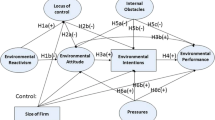Abstract
The aim of this paper is to analyze the determinants of the strategic environmental behavior of firms and, more specifically, the external and internal barriers that limit and sometimes even prevent the environmental adaptation. The analysis focuses on a sample of industrial firms that have at least three workers and that are located in Aragón, a region situated in the northeast of Spain. In order to achieve this objective, first the theoretical literature on the topic is reviewed. Subsequently, from the firms which were sampled, the existence of an underlying structure among the totality of barriers is studied. Finally, this structure is analyzed in order to determine if it has any influence on the degree of proactivity of the firm’s environmental strategy.
Similar content being viewed by others
Notes
The production of firms in Aragon currently represents 3.1 percent of the Gross Domestic Product.
The names of the strategies were omitted in the table in order not to condition the selection.
References
Aragón-Correa, J. A. (1998). Strategic proactivity and firm approach to the natural environment. Academy of Management Journal, 41(5), 556–567.
Brío-González, J. A., & Junquera-Cimadevilla, B. (2002). Implicaciones organizativas de la introducción de tecnologías medioambientales en las empresas: Un estudio empírico de España. Información Comercial Española, 803, 163–175.
Brío-González, J. A., & Junquera-Cimadevilla, B. (2003). A review of the literature on environmental innovation management in SMEs: Implications for public policies. Technovation, 23, 939–948.
Buysse, K., & Verbeke, A. (2003). Proactive environmental strategies: A stakeholder management perspective. Strategic Management Journal, 24(5), 453–470.
Dieleman, H., & de Hoo, S. (1993). Toward a tailor-made process of pollution prevention and cleaner production: Results and implications of the PRISMA project. In K. Fischer & J. Schot (Eds.), Environmental strategies for industry (pp. 245–275). Washington: Island.
Fineman, S., & Clarke, K. (1996). Green stakeholders: Industry interpretations and response. Journal of Management Studies, 33(6), 715–730.
Gray, W. B., & Shadbegian, R. J. (1998). Environmental regulation, investment timing and technology choice. Journal of Industrial Economics, 46(2), 235–256.
Hahn, R. W., & Stavins, R. N. (1992). Economic incentives for environmental protection: Integrating theory and practice. The American Economic Review, 82(2), 464–468.
Henriques, I., & Sadorsky, P. (1996). The determinants of an environmentally responsive firm: An empirical approach. Journal of Environmental Economics and Management, 30, 381–395.
Henriques, I., & Sadorsky, P. (1999). The relationship between environmental commitment and managerial perceptions of stakeholders importance. Academy of Management Journal, 42(1), 87–99.
Hillary, R. (2004). Environmental management systems and the smaller enterprise. Journal of Cleaner Production, 12, 561–569.
Hunt, C. B., & Auster, E. R. (1990). Proactive environmental management: Avoiding the toxic trap. Sloan Management Review, 31(2), 7–18.
Jaffe, A. B., & Stavins, R. N. (1995). Dynamic incentives of environmental regulations: The effects of alternative policy instruments on technology diffusion. Journal of Environmental Economics and Management, 29(3), 43–63.
Kemp, R. (1993). An economic analysis of cleaner technology: Theory and evidence. In K. Fischer & J. Schot (Eds.), Environmental strategies for industry (pp. 79–113). Washington: Island.
Moors, E. H. M., Mulder, K. F., & Vergragt, P. J. (2005). Towards cleaner production: Barriers and strategies in the base metals producing industry. Journal of Cleaner Production, 13(7), 657–668.
Post, J. E., & Altman, B. W. (1994). Managing the environmental change process: Barriers and opportunities. Journal of Organizational Change Management, 7(4), 64–81.
Roome, N. (1992). Developing environmental management strategies. Business Strategy and the Environment, 1(1), 11–24.
Roy, M. J., & Vézina, R. (2001). Environmental performance as a basis of competitive strategy: Opportunities and threats. Corporate Environmental Strategy, 8(4), 339–347.
Sharma, S., & Vredenburg, H. (1998). Proactive corporate environmental strategy and the development of competitively valuable organizational capabilities. Strategic Management Journal, 19(8), 729–753.
Starik, M., & Rands, G. P. (1995). Weaving an integrated web: Multilevel and multisystem perspectives of ecologically sustainable organizations. Academy of Management Review, 20(4), 908–935.
Van Hemel, C., & Cramer, J. (2002). Barriers and stimuli for ecodesign en SMEs. Journal of Cleaner Production, 10, 439–453.
Vastag, G., Kerekes, S., & Rondinelli, D. A. (1996). Evaluation of corporate environmental management approaches: A framework and application. International Journal of Production Economics, 43(2–3), 193–211.
Zilahy, G. (2004). Organizational factors determining the implementation of cleaner production measures in the corporate sector. Journal of Cleaner Production, 12, 311–319.
Acknowledgment
This paper is part of the results obtained under the framework of the research project, SEJ2005-07341, financed by MCYT-FEDER, and thanks to the sponsorship of FUNDEAR (Fundación de Economía Aragonesa).
Author information
Authors and Affiliations
Corresponding author
Rights and permissions
About this article
Cite this article
Murillo-Luna, J.L., Garcés-Ayerbe, C. & Rivera-Torres, P. What Prevents Firms from Advancing in their Environmental Strategy?. Int Adv Econ Res 13, 35–46 (2007). https://doi.org/10.1007/s11294-006-9059-6
Received:
Published:
Issue Date:
DOI: https://doi.org/10.1007/s11294-006-9059-6




